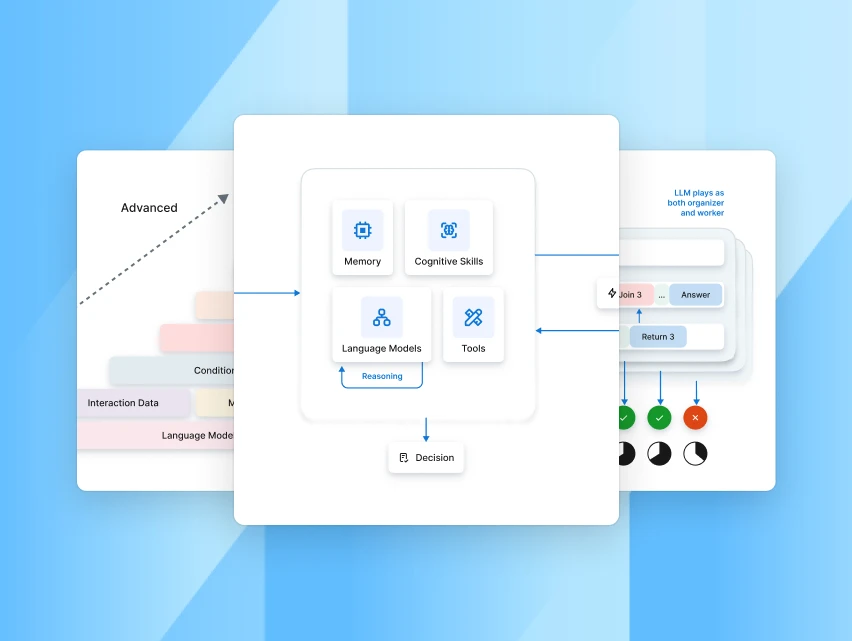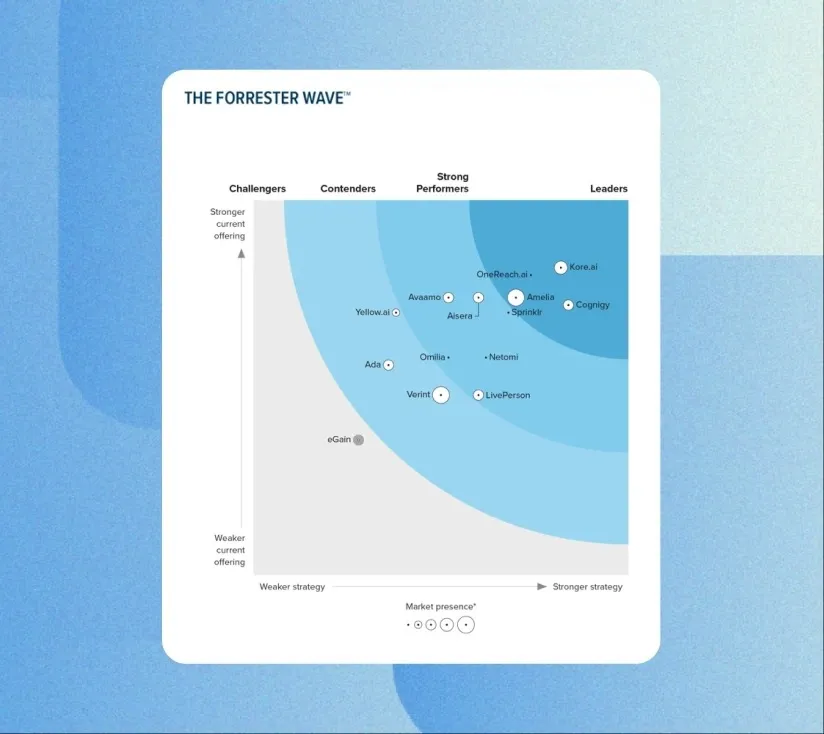Artificial intelligence (AI) has become a ubiquitous term, yet it encompasses a spectrum of technologies with different capabilities. From the reactive machine AI that can beat grandmasters at chess to the still‑theoretical self‑aware AI, the field includes systems that learn, adapt, and sometimes act autonomously. Meanwhile, businesses are also investing heavily in automation, which often gets conflated with AI. To harness these technologies effectively, it’s important to understand the types of artificial intelligence, how they differ from automation, and what kinds of use cases are emerging across industries.
This guide unpacks AI in two parts: first, by exploring AI types based on capabilities and functionalities, then by offering a forward‑looking perspective on where AI may head next. Each section includes examples and real‑world applications to illustrate the concepts in action.
Types of AI based on capabilities
Researchers classify AI by how broadly it can think and act. The three types of AI by its capabilities are - Artificial Narrow Intelligence, Artificial General Intelligence and Artificial Superintelligence, reflect ascending levels of capability.
1. Artificial narrow intelligence (ANI)
Artificial Narrow Intelligence, also called weak AI, is designed to perform specific tasks and lacks generalisation. Narrow AI is trained for a purpose and cannot generalise beyond its scope. Despite these limitations, it powers many everyday services:
- Examples: Voice assistants such as Siri and Alexa understand specific commands, facial recognition software secures devices, and recommendation engines suggest movies or products
- Use cases: Narrow AI is used in customer support chatbots, fraud detection, personalised marketing, predictive maintenance, language translation and more. In manufacturing, narrow AI optimises production lines; in logistics it routes deliveries and forecasts demand.
While narrow AI lacks human‑level understanding, its efficiency in specific domains has made it the most widely deployed form of AI.
2. Artificial General Intelligence (AGI)
Artificial General Intelligence refers to machines that can understand, learn and apply knowledge across a wide range of tasks, matching or surpassing human cognitive ability. General AI systems would have consciousness, self‑awareness and the ability to make independent decisions. AGI remains a theoretical concept, but researchers envision potential applications:
- Examples (conceptual): Robots that adapt to unforeseen challenges or learn new skills in real time; AI doctors capable of diagnosing and treating complex medical conditions across multiple specialities.
- Use cases: AGI could revolutionise research by autonomously designing experiments, accelerate drug discovery, or provide personalised education by tailoring curricula to individual needs. It may also assist in complex decision-making in fields like law and policy.
AGI would transform nearly every industry, but achieving such broad intelligence requires breakthroughs in understanding consciousness and building machines that can generalise across domains.
3. Artificial Superintelligence (ASI)
Artificial Superintelligence refers to AI systems that surpass human intelligence in creativity, problem‑solving and empathy. Super AI is a system that develops their own desires and beliefs, making decisions independently. Super AI would outperform human problems‑solving and interpreting emotions. ASI is entirely speculative, yet it provokes deep thought about potential benefits and risks:
- Examples (speculative): An AI scientist producing theories that humans could never conceive, or an artist generating masterpieces beyond the human imagination.
- Use cases: Super intelligent systems might accelerate climate modelling, guide policy decisions, or solve complex mathematical problems. However, questions about control, alignment and ethics become critical when imagining machines with capabilities far beyond human comprehension.
Though super AI remains far off, exploring its possibilities encourages discussions about safety, governance and responsible innovation.
Types of AI Based on Functionalities
Another way to classify AI is by how it functions. This framework includes four (often called five) types: Reactive Machines, Limited Memory AI, Theory of Mind AI and Self‑Aware AI. Each type builds upon the previous one to bring AI closer to humans‑like cognition.
1. Reactive Machines
Reactive machines are the simplest AI systems. They do not store memories or learn from experience; instead, they respond to current inputs with fixed outputs. Reactive machines are task‑specific and always produce the same output for a given input. Classic examples include IBM’s Deep Blue chess engine and Google’s AlphaGo, which use pattern recognition but cannot learn from past games. Reactive AI is widely used today:
- Examples: Chess engines, spam filters, simple recommendation algorithms and industrial robots that follow programmed instructions.
- Use cases: Reactive AI is ideal for applications where data is well‑structured and tasks do not require adaptation. It drives real‑time strategy in games, automates repetitive actions in manufacturing and filters content online.
2. Limited Memory AI
Most modern AI falls under limited memory AI, where systems learn from historical data to make decisions. Limited memory models can look into the past, learn and adapt based on new data, though they do not retain long‑term memories like humans.
- Examples: Self‑driving cars that observe traffic conditions and adjust speed accordingly; virtual assistants that remember recent conversation context to improve responses.
- Use cases: Limited memory AI powers autonomous vehicles, predictive maintenance, credit scoring, dynamic pricing, language translation and voice assistants. It sits at the heart of machine learning algorithms used in finance, retail, healthcare and entertainment.
3. Theory of Mind AI
Theory of Mind AI aims to understand human emotions, beliefs and intentions. This AI would engage in sophisticated interactions by perceiving emotions and adjusting behaviour accordingly.
- Examples (experimental): Social robots that interpret facial expressions to adjust tone, or digital assistants in healthcare that recognise patient emotions and respond empathetically.
- Use cases: Emotion‑aware AI can enhance customer service by tailoring interactions, support mental health through empathetic responses, and collaborate with humans in manufacturing by adjusting pace and behaviour based on worker stress or fatigue.
Theory of Mind AI is still in development, but progress in affective computing and behavioural analysis suggests that machines may soon interact with us more naturally.
4. Self‑Aware AI
Self‑Aware AI represents the ultimate goal for many AI researchers: machines with consciousness and self‑awareness. self‑aware AI as systems that not only understand emotions but also possess their own consciousness. Self‑aware AI would have its own thoughts and desires. No such AI exists, but the idea fuels speculation:
- Examples (hypothetical): An AI that knows its goals and state, perhaps deciding to recharge because it wants to survive, or refusing tasks if they conflict with its “ethics.”
- Use cases: If achieved, self‑aware AI could drive fully autonomous vehicles that understand moral dilemmas, robots that make ethical decisions in healthcare or disaster response, and AI artists that create based on internal preferences.
Self‑awareness opens philosophical debates about identity, rights and the boundaries between humans and machines.
Future Directions and Agentic AI
AI is not standing still. Several trends suggest where it might head next:
1. Intelligent automation and hyper-automation
By combining automation with AI, organisations can create workflows that execute tasks, analyse data and adapt in real time. Intelligent automation as an end‑to‑end process that not only performs repetitive tasks but also analyses data to make decisions and adapt without human intervention. Examples include AI‑powered chatbots that interpret customer queries and provide immediate answers, freeing human agents to handle complex issues.
2. Agentic AI and multi‑agent systems
The next frontier is agentic AI, where multiple AI agents collaborate and orchestrate tasks autonomously. Agentic systems coordinate planning, reasoning and execution across various agents. In enterprise settings, they could manage entire workflows, like automatically triaging IT tickets, deploying the right agents to solve them, and learning from outcomes to improve efficiency. Multi‑agent orchestration is a major focus for companies like Kore.ai, emphasising agentic AI rather than just conversational agents.
3. AI’s relationship with automation
Businesses often adopt automation first for efficiency, then add AI to gain intelligence. Automation focuses on performing repetitive, unchanging tasks, while AI dynamically responds to new information. Combined, they create smart workflows. For example, robotic process automation (RPA) moves data between systems; AI analyses that data to detect anomalies or predict outcomes, forming an intelligent automation loop.
4. Ethical considerations and human alignment
As AI advances, ethical questions become more pressing. AI that learns from biased data can perpetuate discrimination. Super intelligent systems raise concerns about control and alignment. Theory of Mind and self‑aware AI would require a new understanding of rights and responsibilities. Organisations and regulators must develop frameworks to ensure transparency, fairness and accountability in AI use.
5. A futuristic take on self‑aware and super AI
Though self‑aware AI and superintelligence remain speculative, exploring them helps steer current research responsibly. Future AI may integrate self‑awareness at a limited level, recognising when it’s overworked or needs maintenance, for instance. Super AI could be deployed in controlled environments to accelerate scientific discovery or predict climate phenomena. The real breakthrough may come from AI that combines emotional intelligence with reasoning to act as a true collaborator, not just a tool.
Conclusion
AI encompasses a spectrum of technologies, from the reactive machine AI that powers simple automation to the hypothetical self‑aware AI of science fiction. By distinguishing automation from AI and understanding the types of AI based on capabilities and functionalities, businesses and individuals can deploy the right tools for the right tasks. Artificial Narrow Intelligence excels at specific jobs, Artificial General Intelligence aims for human‑level adaptability, and Artificial Superintelligence remains a distant but provocative goal. Functionally, Reactive Machines respond to immediate inputs, Limited Memory AI learns from data, Theory of Mind AI seeks to understand emotions and intentions, and Self‑Aware AI, if achieved, would blur the line between human and machine.
Combining automation and AI yields intelligent workflows that adapt and improve over time. Looking ahead, agentic AI and multi‑agent systems will coordinate complex tasks autonomously, while ethical governance will be crucial to ensure AI serves humanity. Understanding these distinctions and trajectories prepares us for a future where AI is not just a tool, but a partner in solving the world’s most challenging problems











.webp)





.webp)
